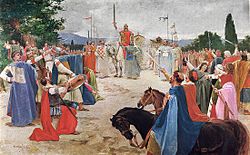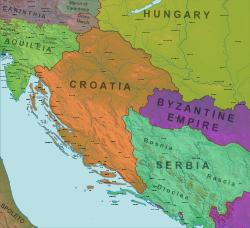Croats
Croats (Croatian: [Hrvati] Error: {{Lang}}: text has italic markup (help)) are a South Slavic ethnic group mostly living in Croatia, Bosnia and Herzegovina and nearby countries. There are around 5 million Croats living in the southern Central Europe region, along the east bank of the Adriatic Sea and an estimated 9 million throughout the world. Large Croat communities exist in a number of countries, including Chile, the United States, Argentina, Australia, Germany, New Zealand and South Africa. Croats are noted for their unique culture, which comes from their location in Europe which subjected them to various non European influences. The Croats are predominantly Catholic and their language is Croatian.
 | |
| Total population | |
|---|---|
| c. 7–9 million[a] | |
| Regions with significant populations | |
3,874,321 (2011)[1] 544,780 (2013)[2] | |
| 414,714 (2012)[3] – 1.2 million[4] | |
| 441,000 (2016)[5] | |
| 200,000 – 380,000[6] | |
| 250,000 | |
| 150,719 (2001) | |
| 133,268 (2016) | |
| 114,880 (2011)[7] | |
| 57,900 (2011) | |
| 40,848 (2006) | |
| 40,000 (est.)[8] | |
| 35,642 | |
| 35,000 (est.)[9] | |
| 2,673–60,000 (2013 est.)[10][11] | |
| 23,561 | |
| 21,360 | |
| 20,000 (est.) | |
| 10,000[12] | |
| 8,000 | |
| 6,992 | |
| 6,786 | |
| 6,021 | |
| 6,000 | |
| 5,400 | |
| 5,272[13] | |
| 5,000[14] | |
| 4,000[15] | |
| 2,600 | |
| 2,490[16] | |
| 1, 100 | |
| Europe | c. 5.3 million |
| North America | c. 530,000 – 2,500,000[b] |
| South America | c. 470,000–650,000 |
| Asia | c. 146,008-211-478 |
| Other | c. 140,000–250,000 |
| Languages | |
| Croatian | |
| Religion | |
| Predominantly Roman Catholicism | |
| Related ethnic groups | |
| Other South Slavs | |
a The total figure is merely an estimation; sum of all the referenced populations. b References: [17][18][19] [20][21][22][23] | |
Croats Media
The range of Slavic ceramics of the Prague-Penkovka culture marked in black, all known ethnonyms of Croats are within this area. Presumable migration routes of Croats are indicated by arrows, per V.V. Sedov (1979).
Arrival of the Croats to the Adriatic Sea by Oton Iveković
Branimir Inscription (9th-century) from Šopot near Benkovac in Croatia, as "Dux Cruatorum", has the earliest carved ethnonym Hrvat (Cruat-/Crvat-) in the form which is still pronounced today.
Coronation of King Tomislav by Oton Iveković.
Kingdom of Croatia and Dalmatia during Zvonimir's reign, at the beginning of 1089.
Baška tablet, which is the oldest evidence of the glagolitic script, mentions king Zvonimir.
Pacta Conventa, is a historical document by which Croatia agreed to enter a personal union with Hungary. Although the validity of the document itself is disputed, Croatia did keep considerable autonomy.
Croatia in personal union with Hungary and Ottoman expansion in the region in 1500
Zrínyi's charge on the Turks from the Fortress of Szigetvár, by Simon Hollósy
The Cetingrad Charter from 1 January 1527, when Croatian Sabor elected the Habsburg monarchy.
Related pages
References
- ↑ "Central Bureau of Statistics". Dzs.hr. Archived from the original on 2019-05-17. Retrieved 2013-03-26.
- ↑ Sarajevo, juni 2016. CENZUS OF POPULATION, HOUSEHOLDS AND DWELLINGS IN BOSNIA AND HERZEGOVINA, 2013 FINAL RESULTS (PDF). BHAS. Archived from the original (PDF) on 24 December 2017. Retrieved 30 June 2016.
- ↑ Results American Fact Finder (US Census Bureau)
- ↑ Croatian diaspora in the USA Archived 2019-02-06 at the Wayback Machine It has been estimated that around 1.200.000 Croats and their descendants live in the USA.
- ↑ "State Office for Croats Abroad". Hrvatiizvanrh.hr. Archived from the original on 30 September 2018. Retrieved 18 March 2015.
- ↑ Diaspora Croata El Ministerio de Relaciones Exteriores de la República de Chile evalúa que en ese país actualmente viven 380.000 personas consideradas de ser de descendencia croata, lo que es un 2,4% de la población total de Chile.
- ↑ "2011 National Household Survey: Data tables". 8 May 2013. Retrieved 18 March 2015.
- ↑ "Présentation de la Croatie" (in French). Ministry of Foreign Affairs and International Development. Retrieved 28 June 2016.
{{cite web}}: CS1 maint: unrecognized language (link) - ↑ "Hrvatsko iseljeništvo u Švedskoj". Hrvatiizvanrh.hr (in Croatian). Archived from the original on 20 February 2019. Retrieved 18 March 2015.
{{cite web}}: CS1 maint: unrecognized language (link) - ↑ "7. Facts and figures – Dalmatians – Te Ara Encyclopedia of New Zealand". Retrieved 18 March 2015.
- ↑ "Hrvatsko iseljeništvo u Novom Zelandu". Hrvatiizvanrh.hr (in Croatian). Archived from the original on 6 February 2019. Retrieved 18 March 2015.
{{cite web}}: CS1 maint: unrecognized language (link) - ↑ "State Office for Croats Abroad". Hrvatiizvanrh.hr. Archived from the original on 20 February 2019. Retrieved 18 March 2015.
- ↑ "Population by immigrant category and country background". Statistics Norway. 1 January 2015. Retrieved 18 March 2015.
- ↑ "Hrvatsko iseljeništvo u Ekvadoru" (in Croatian). Archived from the original on 26 January 2019. Retrieved 18 March 2015.
{{cite web}}: CS1 maint: unrecognized language (link) - ↑ "State Office for Croats Abroad". Hrvatiizvanrh.hr. Archived from the original on 1 February 2019. Retrieved 18 March 2015.
- ↑ "Croats of Czech Republic: Ethnic People Profile". czso.cz. Czech Statistical Office. Archived from the original on 9 March 2021. Retrieved 17 April 2017.
- ↑ Farkas, Evelyn (2003). Fractured States and U.S. Foreign Policy. Iraq, Ethiopia, and Bosnia in the 1990s. Palgrave Macmillan US. p. 99.
- ↑ Paquin, Jonathan (2010). A Stability-Seeking Power: US Foreign Policy and Secessionist Conflicts. McGill-Queen's University Press. p. 68. ISBN 9780773591028.
- ↑ Directory of Historical Organizations in the United States and Canada. American Association for State and Local History. 2002. p. 205.
- ↑ Zanger, Mark (2001). The American Ethnic Cookbook for Students. Greenwood. p. 80.
- ↑ Levinson, Ember, David, Melvin (1997). American immigrant cultures: builders of a nation. Macmillan. p. 191.
- ↑ Foreign Operations, Export Financing, and Related Programs Appropriations for 1994: Testimony of members of Congress and other interested individuals and organizations. United States. Congress. House. Committee on Appropriations. Subcommittee on Foreign Operations, Export Financing, and Related Programs. 1993. p. 690.
- ↑ National Genealogical Inquirer. Janlen Enterprises. 1979. p. 47.









